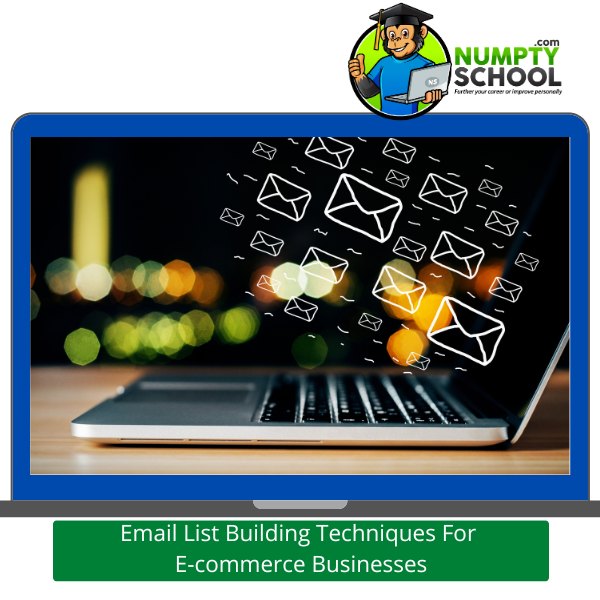Email List Building Techniques For E-commerce Businesses

In today’s competitive e-commerce landscape, building and nurturing a robust email list is not just a marketing strategy but a cornerstone of sustainable business growth. By harnessing the power of email marketing, e-commerce businesses can directly engage with their audience, drive sales, and foster long-term customer relationships. This comprehensive guide explores effective email list building techniques tailored specifically for e-commerce enterprises, ensuring you leverage every opportunity to expand your subscriber base and maximize engagement.
Introduction to Email List Building
Email marketing remains one of the most effective digital marketing channels for e-commerce businesses. It allows direct communication with your audience, delivering personalized messages and promotions. Building a strong email list ensures that you have a receptive audience for your marketing efforts.
Understanding Your Target Audience
Before embarking on any email list building strategy, it’s crucial to define your target audience clearly. Identifying your Ideal Customer Profile (ICP) helps in crafting tailored content and offers that resonate with your potential customers. Conducting thorough market research further refines your segmentation strategy, ensuring that your emails are relevant and impactful.
Creating Compelling Lead Magnets
Lead magnets are incentives offered to potential subscribers in exchange for their email addresses. These can range from downloadable resources like ebooks and guides to exclusive discounts or free trials. Effective lead magnets address a specific pain point or desire of your target audience, compelling them to subscribe.
Optimizing Website Pop-ups
Website pop-ups, when used strategically, can significantly boost your email list growth. Designing non-intrusive yet attention-grabbing pop-ups and timing their appearance based on user behavior enhances their effectiveness. A/B testing different pop-up variations helps in identifying what resonates best with your visitors.
Implementing Content Upgrades
Content upgrades are bonus content pieces directly related to the blog post or webpage a visitor is viewing. By offering additional value in exchange for an email address, such as a checklist or a toolkit, you increase the likelihood of conversion. Integrating content upgrades seamlessly into your content strategy enhances user engagement and email sign-ups.
Utilizing Exit-Intent Pop-ups
Exit-intent pop-ups detect when a visitor is about to leave your website and trigger a targeted message or offer. These pop-ups can be personalized based on the visitor’s browsing behavior or cart contents, providing a last-minute opportunity to capture their email address. Crafting compelling exit-intent offers can effectively reduce bounce rates and recover potentially lost leads.
Running Contests and Giveaways
Contests and giveaways are powerful tools for rapidly growing your email list. By encouraging participants to provide their email addresses for entry, you expand your subscriber base while generating buzz and excitement around your brand. Choosing prizes that align with your target audience’s interests ensures higher quality leads.
Using Social Media for List Building
Social media platforms offer diverse opportunities for e-commerce businesses to attract and convert followers into email subscribers. From hosting exclusive social media contests to sharing gated content that requires an email sign-up, integrating list building tactics into your social media strategy enhances your reach and engagement.
Partnering with Influencers
Collaborating with influencers who resonate with your target audience can exponentially increase your email list growth. Influencers can promote your lead magnets or exclusive offers to their followers, driving traffic and conversions. Establishing mutually beneficial partnerships with influencers ensures that your list growth efforts are targeted and effective.
Optimizing the Checkout Process
Streamlining the checkout process presents a prime opportunity to capture email addresses. Offering incentives such as discounts on future purchases or updates on order status encourages customers to opt-in voluntarily. Implementing seamless opt-in options during checkout ensures minimal friction and maximizes conversion rates.
Segmenting and Personalizing Emails
Segmenting your email list based on demographics, purchase behavior, or engagement level allows for personalized communication tailored to each segment’s interests and preferences. Personalized emails have higher open and click-through rates, fostering stronger customer relationships and driving repeat sales.
Automating Email Campaigns
Email automation simplifies the process of nurturing leads and engaging customers at every stage of their journey. Setting up automated workflows for welcome sequences, abandoned cart reminders, or product recommendations ensures timely and relevant communication without manual intervention. Automation tools help in optimizing your email marketing efforts for efficiency and effectiveness.
Monitoring and Analyzing Performance
Tracking key metrics such as open rates, click-through rates, and conversion rates provides valuable insights into the effectiveness of your email marketing campaigns. Utilizing email analytics tools allows you to identify trends, evaluate campaign performance, and make data-driven decisions to continually improve your email list building strategies.
Maintaining and Growing Your List
Maintaining a healthy email list involves regular hygiene practices such as cleaning inactive subscribers and managing unsubscribes. Continuously testing and optimizing your sign-up forms, content offerings, and email strategies ensures sustained list growth over time. Implementing feedback loops and staying updated with industry trends are essential for adapting your strategies to evolving consumer behaviors.
Conclusion
Building a high-quality email list is not merely about quantity but also about engagement and relevance. By implementing the right strategies tailored to your e-commerce business, you can cultivate a loyal subscriber base that drives consistent traffic and revenue. Remember, effective email list building requires continuous optimization, creativity, and a deep understanding of your audience’s needs and preferences.
FAQs
How can I encourage more visitors to subscribe to my email list?
Offer valuable incentives such as exclusive discounts or informative content through lead magnets.
What are some best practices for designing effective pop-ups?
Ensure pop-ups are visually appealing, non-intrusive, and timed to appear when visitors are most engaged.
Why is email segmentation important for e-commerce businesses?
Segmentation allows you to personalize your messages, increasing relevance and engagement among different customer groups.
How often should I send emails to my subscribers?
It depends on your audience and content strategy, but generally, 1-2 emails per week strikes a balance between staying top-of-mind and avoiding over-saturation.
What metrics should I track to measure the success of my email campaigns?
Key metrics include open rates, click-through rates, conversion rates, and overall list growth.



